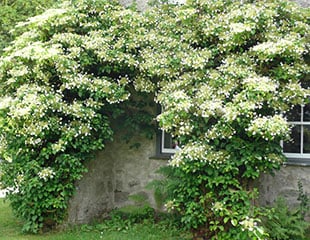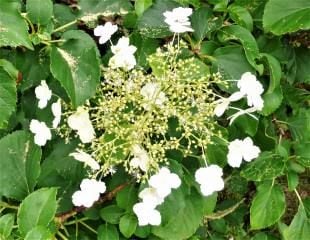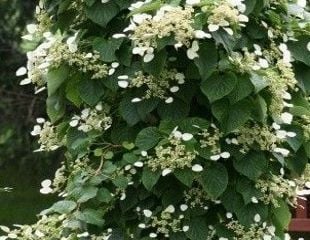


Climbing Hydrangea H. petiolaris
The Climbing Hydrangea is late spring and summer flowering with lovely frothy creamy white flowers. It is deciduous and a self clinging, climbing plant. The most commonly grown in the UK is Hydrangea anomala subsp. petiolaris, widely grown as it is a fully hardy variety most suited for the UK.
Climbing Hydrangea is genuinely easy to grow, too easy, a touch vigorous but not seriously so. It can be slow to get going, but once established, it is fairly fast growing. As with all shrubs, it is important when first planted not to let the shrub dry out. Because it takes time to establish, during which period the shrub is putting down roots, it can take a little while to flowering between 3-5 years.
It is easy to grow because it needs little or no attention. Climbing hydrangea is self clinging with aerial roots. It is good for shady areas as it tolerates semi shade, which makes it ideal for a north-facing wall. The climbing Hydrangea is most suited to growing on moist soil, but it is tough and will grow more or less anywhere, except for hot dry sunny borders.
When considering where to plant a climbing Hydrangea bear in mind, it can become large over time. Climbing hydrangeas can reach up to 25m (80ft) which means it will cover an extensive area, the whole of a fascia of a house in about 10-15 years if grown in ideal conditions. This makes a climbing hydrangea less suited to growing in containers. The large the plant generally the water it requires and a plant of this size growing in a container is going to need a lot of watering and it stops becoming low maintenance. I'm not saying you can't grow it in a container, but it will require a lot of attention.
An additional bonus is that the Climbing Hydrangea is completely hardy, -15 to -10 cold winter Hardy in most places throughout the UK even in severe winters.
Climbing Hydrangea is a reliable climbing plant flowering every year with lovely, frothy, creamy white flowers and bright, almost lime, green foliage. The climbing hydrangea is suitable for growing anywhere in the UK.
How to Prune Climbing Hydrangea

Climbing Hydrangea does not require routine pruning. If it outgrows its allotted space, pruning can check it. The best time to trim back climbing Hydrangea is after flowering in late summer.
Because the plant produces flowers on the previous year's wood, pruning earlier in the year sacrifices that year's flowers.
If you inherit an overgrown Climbing hydrangea, it is best not to hard prune it. Prune it back and reshape over 2-3 years.
One attraction of growing Climbing hydrangea is the lovely, creamy white flowers which appear in the spring. It flowers prolifically and although not scented; they are delicate and attractive.
Climbing Hydrangea in winter

Climbing Hydrangea is deciduous which means it looses all its foliage in winter. This image shows a Climbing Hydrangea in winter and it is quite bear.
The positive aspect is that in spring, it produces fresh and vibrant foliage, abundant flowers, and becomes covered in flowers.

I have tagged this Hydrangea a green wheelbarrow shrub it is easy to grow. Planted in the right place it can be left to its own devices.
